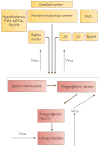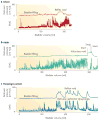The neural control of micturition
- PMID: 18490916
- PMCID: PMC2897743
- DOI: 10.1038/nrn2401
The neural control of micturition
Abstract
Micturition, or urination, occurs involuntarily in infants and young children until the age of 3 to 5 years, after which it is regulated voluntarily. The neural circuitry that controls this process is complex and highly distributed: it involves pathways at many levels of the brain, the spinal cord and the peripheral nervous system and is mediated by multiple neurotransmitters. Diseases or injuries of the nervous system in adults can cause the re-emergence of involuntary or reflex micturition, leading to urinary incontinence. This is a major health problem, especially in those with neurological impairment. Here we review the neural control of micturition and how disruption of this control leads to abnormal storage and release of urine.
Conflict of interest statement
Figures








References
-
- Morrison J, et al. In: Incontinence. Abrams P, Cardozo L, Khoury S, Wein A, editors. Health Publications Ltd; Jersey: 2005. pp. 363–422.
-
This book chapter provides a comprehensive review of the neural control of the lower urinary tract.
-
- Fry CH, et al. In: Incontinence. Abrams P, Cardozo L, Khoury S, Wein A, editors. Health Publications Ltd; Jersey: 2005. pp. 313–362.
-
- de Groat WC, Booth AM. In: Nervous Control of the Urogenital System (Autonomic Nervous System) Maggi CA, editor. Vol. 3. Harwood Academic Publishers; London: 1993. pp. 291–347. Ch. 9.
-
- Andersson KE, Arner A. Urinary bladder contraction and relaxation: physiology and pathophysiology. Physiol Rev. 2004;84:935–986. - PubMed
Publication types
MeSH terms
Substances
Grants and funding
LinkOut - more resources
Full Text Sources
Other Literature Sources
Medical

